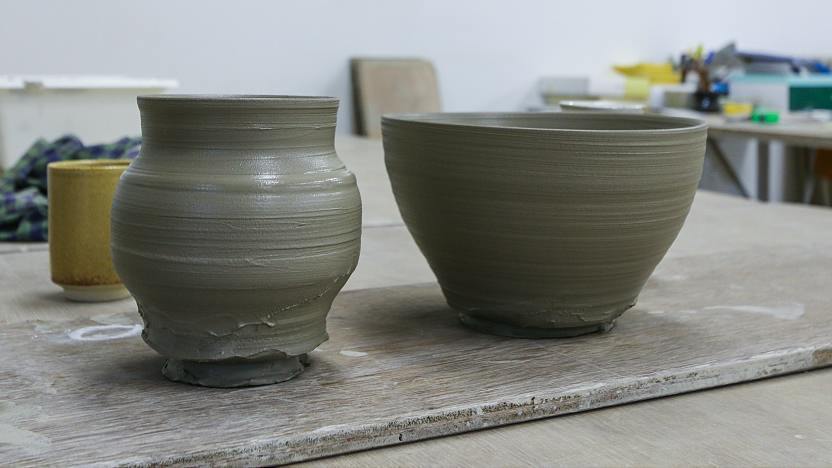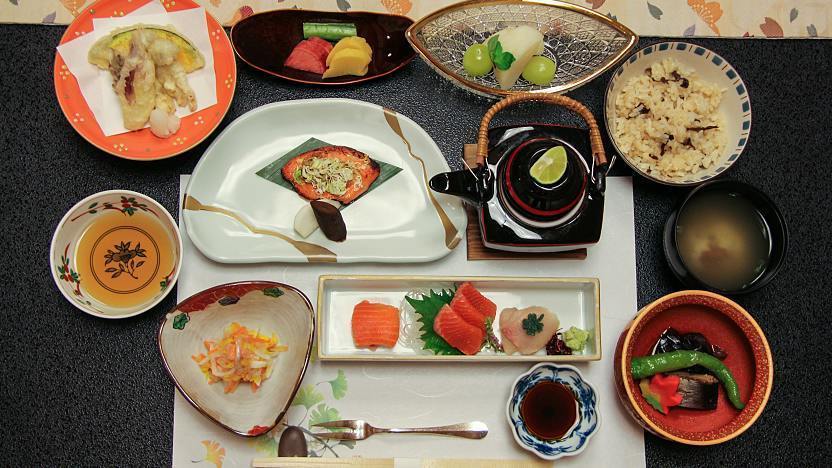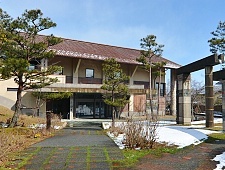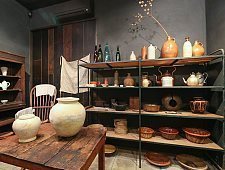Japanese Pottery

Pottery is one of the most famous Japanese art forms. Tourists can admire classic ceramic ware in museums, visit famous pottery towns, participate in pottery-related activities or enjoy tableware at restaurants.
The earliest forms of ceramics in Japan were found about 10,000 years ago during the Jomon Period (13,000 BC to 300 BC) when most inhabitants were hunters and gatherers. The era's name, Jomon, refers to the typical patterns seen on the contemporary pottery which was made unglazed and baked in large bonfires. It was not until the Kofun Period (300 AD to 538 AD) that firing techniques were further developed and covered kilns were used.

Early Japanese ceramics were either stoneware or earthenware. Earthenware was fired at lower temperatures but was typically porous if left unglazed, while stoneware was fired at higher temperatures and yielded vessels that were non-porous, i.e. they did not need to be further glazed to make them waterproof.
In the early 1600s, kaolin, the clay required to make porcelain, was first discovered in Japan in the town of Arita. Compared to previous ceramics, porcelain allowed for the production of stronger and more durable, yet thinner vessels.
Pottery styles
There are over 50 famous pottery towns and districts across Japan, each with their own characteristics and differences in the clay, glaze and firing method used. Below is a list of some of the most popular pottery styles and related sightseeing spots:

Arita-yaki
A must-see destination for Japanese pottery fans, Arita is the birthplace of porcelain in Japan with the discovery of kaolin in a nearby stone quarry. Arita ware tends to be made of porcelain with painted designs. Paint colors used in Arita-yaki include red, gold, yellow and green, and may resemble Kutani-yaki; however, the use of cobalt blue is its most distinguishing feature.
Kutani-yaki
Kutani-yaki started in the beginning of the Edo Period (1603-1868) in Ishikawa Prefecture (then Kaga Province), not long after the Maeda Clan came into power to be the lords of Kaga and one of the richest clans in the country. Kutani-yaki tends to have drawings with bold colors like red, yellow, blue and green that are easy to recognize. Some may consider Kutani-yaki to be slightly gaudy, but the colors and intricate designs show off the skill of the artists.
Mashiko-yaki
Compared to many of the other ceramics town in Japan, Mashiko-yaki has a relatively short history and only came about in the 19th century. The clay used in Mashiko-yaki tends to be rough rather than smooth and usually has a higher iron content resulting in a finished product with copper hues. There are a number of traditional Mashiko-yaki glazes, including off-white, matt black and celadon. Mashiko wares became popular as everyday tableware after the Meiji Period when the local craft flourished in the country and resulted in many potters in the town.
Shigaraki-yaki
Shigaraki-yaki is made in southern Shiga Prefecture and is one of the oldest pottery centers in Japan, alongside Bizen in Okayama. The region is the largest producer of ceramic tanuki (racoon dogs) in the country. High-quality clay mixed with minuscule, coarse stones is one of the features that ensured the longevity of the tradition, and shigaraki ware is often unglazed or adorned with simple designs.
Raku-yaki
Based in Kyoto, the Raku family has been producing tea bowls with muted designs and colors for about 450 years. The techniques and philosophy behind making the first raku wares were a collaboration between the founder of the family and famed tea master Sen no Rikyu, and the tradition still continues today with the 15th generation of the Raku family. Raku tea bowls fetch a high price and are highly sought after in the tea ceremony world.
Bizen-yaki
Bizen-yaki is named after the old province of Bizen which makes up the eastern side of today's Okayama Prefecture. It is one of the oldest styles of pottery in Japan. Bizen ware is not glazed, but instead is fired at temperatures of between 1200 to 1300 degrees Celsius. This results in a typically reddish-brown shade which is a distinguishing feature of Bizen-yaki.
Hagi-yaki
Hagi-yaki is named after Hagi, a pretty, former castle town in Yamaguchi Prefecture along the Sea of Japan coast. Hagi ware tends to be simple and unadorned, and its traditional glazes include a thick white that covers up the clay and a thinner white that allows the shape and color of the clay to come through. Several pottery-related attractions can be found across town, including some museums and shops
Karatsu-yaki
Karatsu-yaki has its origins in Karatsu, a port town in Saga Prefecture. Karatsu-ware has very sedate tones, resembling Bizen-yaki, with a thin layer of glaze. Karatsu ceramics do not come in loud colors nor have flashy designs, with the artists often opting for a simple accents or glaze.
Tsuboya-yaki
Tsuboya-yaki is the most famous pottery from Okinawa. Common products include large storage vessels for awamori and other liquids and foods, and shisa, ceramic lion-dog statues that are placed on roofs or entrance gates to protect against evil.
How to participate in a pottery making activity
Pottery activities are offered by museums, craft villages and individual workshops across Japan, especially in famous pottery towns. Sessions are typically two hours long and cost around 1500 to 6000 yen. Reservations are usually required to participate in a pottery making activity, but some places in pottery towns allow for walk-in customers. Note that English-speaking studios are far and few, but some listings can be found on activity reservation websites, such as Klook and Wabunka.
In pottery activities for tourists the vessels are created using a pottery wheel or are entirely hand-formed. A typical experience begins with the instructor showing the basics of how to throw or knead the clay. Students then form their vessels under the watchful eyes of the instructor. Given two hours, most people can form 3-5 vessels on an electric wheel, while those using just their hands are typically limited to one vessel.
Studio staff will trim your freshly formed vessels thrown on the electric wheel, while hand-formed vessels are not usually trimmed. After the end of the activity, the vessels will be air-dried, fired once and then glazed before being fired again in a kiln. The entire process can take more than a month as the kiln is typically filled to capacity before firing. Afterwards, the creations are delivered to the activity participants by mail.

How to appreciate Japanese ceramics
Today, it is common to see Japanese pottery being used in everyday life, and prized ceramics are treated like precious silver, only brought out on special occasions. When dining at nice restaurants or ryokan, ceramic dishes are often carefully chosen to reflect the season and mood. Embellished ceramic dishes can take the place of food decoration, adding to the visual dimension of the dish.
In the tea ceremony, the ceramic tea bowl (chawan) is a central tool. All the different pottery regions in Japan produce their versions of the tea bowl. The bowls are typically handmade, range in shape, size and color, and no two bowls should be the same. It is considered good manners to inspect your tea bowl after drinking the tea to appreciate its form and design.

Where to buy Japanese pottery
Pottery towns in Japan are generally good places to find ceramic wares. For those who do not have a preference for regional brands, department stores and upmarket stores curate their selection of pottery products, while at the opposite end of the spectrum mass-produced ceramic tableware can be found at 100 yen stores.

Questions? Ask in our forum.
















